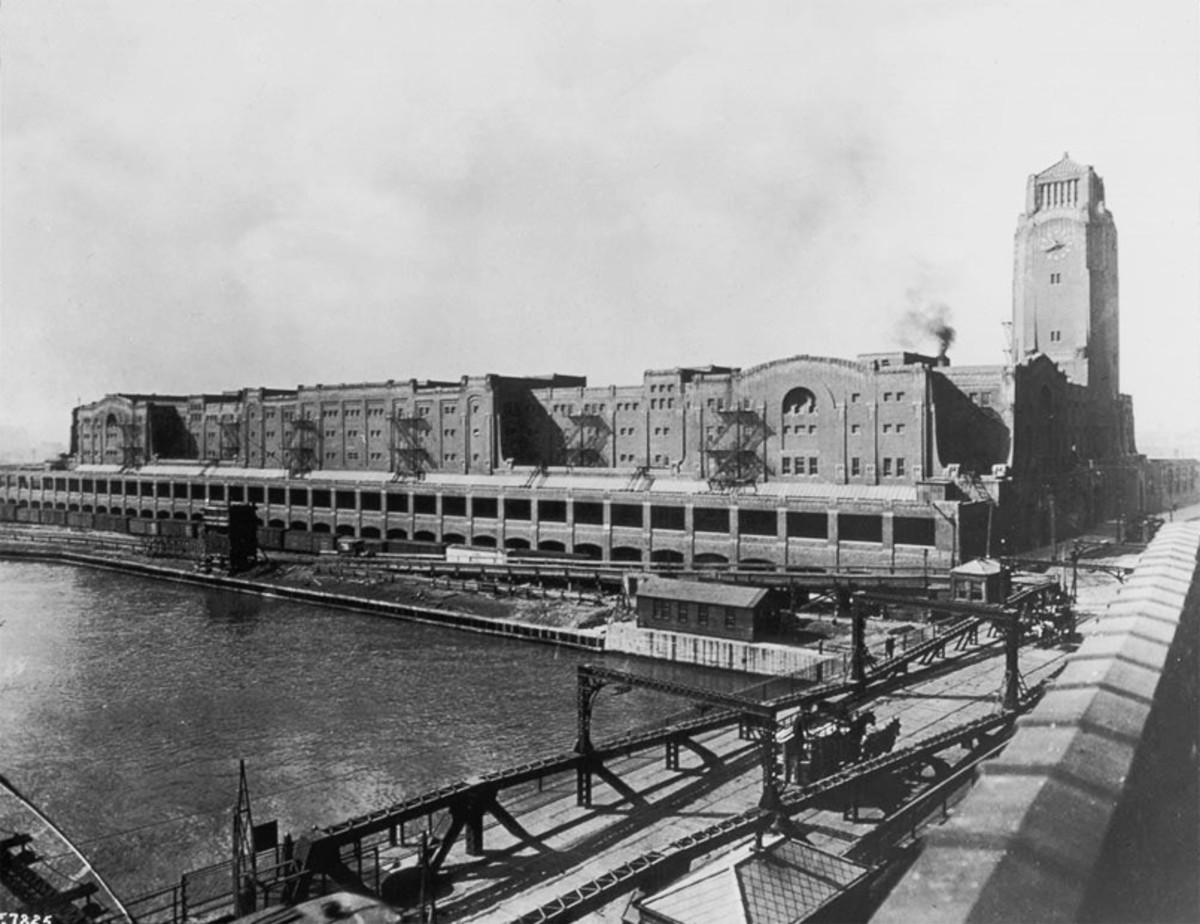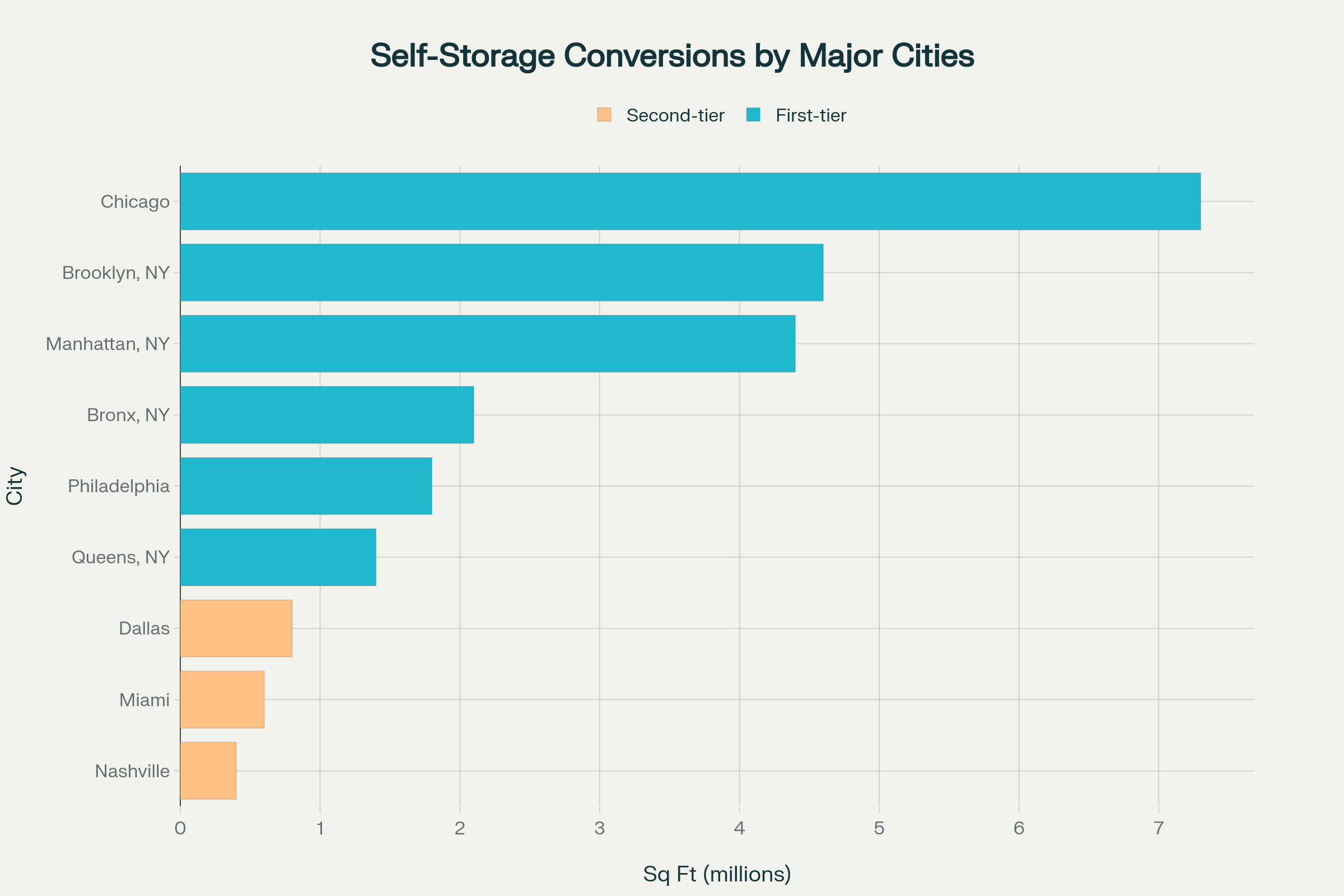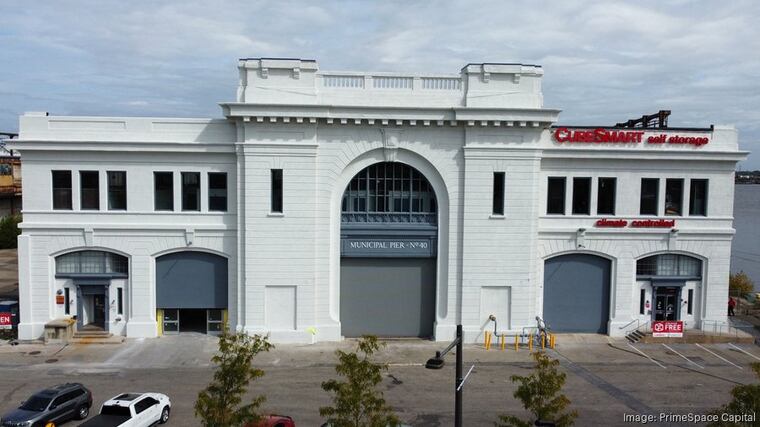

The Great American Storage Revolution: How Our Industrial Past Is Reshaping Our Stuff-Obsessed Future
July 16, 2025
Executive Summary
Cities with deep industrial roots like Chicago and New York are pioneering self-storage conversions, leveraging sturdy, zoned buildings. By contrast, rapidly growing Sun Belt markets lack viable conversion candidates, leading instead to new construction.
Key Points:
- Approximately 9% (~191 million sq ft) of U.S. self-storage comes from conversions; ~78% originate from industrial buildings.
- Chicago leads conversion totals (7.3M sq ft); Brooklyn alone has converted 4.6M across 42 properties, now used for storage.
- Industrial buildings offer ideal features: high ceilings, open floors, loading docks, zoning making conversions cost effective.
- In contrast, cities like Dallas, Miami, and Nashville rely on ground-up builds due to less existing industrial stock.
- Conversions cost less ($45-85/sf vs. $90-12/sf new build), often at slightly lower rents, but yield strong ROI.
Regional Trends in Self-Storage Conversions
I was walking through Brooklyn's Gowanus neighborhood last month when my friend Sarah, a real estate developer, pointed to a gleaming new self-storage facility and said something that stopped me in my tracks: "You know, Charley, that used to be where they made those beautiful cast-iron radiators that heated half of New York for a century." As we stood there watching millennials wheeling their belongings into climate-controlled units, I realized we were witnessing something profound—the physical manifestation of America's economic transformation, one converted warehouse at a time.
What Sarah showed me wasn't just urban renewal; it was a microcosm of how America's industrial heartland is adapting to our post-manufacturing, hyper-mobile, stuff-accumulating economy. Across the country, from Chicago's old steel districts to Philadelphia's former textile mills, cities with rich industrial histories are leading an unexpected revolution: turning the bones of their manufacturing past into the storage solutions of our digital future.
The Conversion Economy Takes Root
The numbers tell a story that would make any economist's head spin. According to recent industry data, roughly 191 million square feet of America's self-storage inventory—that's about 9% of the total—now comes from converted buildings rather than ground-up construction[1][2]. To put that in perspective, we're talking about repurposing space equivalent to about 50 average Walmart Supercenters, but instead of selling us more stuff, these facilities are helping us store the stuff we already have.
Here's where it gets interesting: 78% of these conversions are happening in former industrial buildings, with another 16% coming from retail spaces[1][3].
This isn't random—it's the market's invisible hand at work, efficiently reallocating resources from yesterday's economy to today's needs.

The geography of this transformation reveals something crucial about American economic geography. Chicago leads the nation with 7.3 million square feet of converted storage space, followed closely by New York City's boroughs[4][5]. Brooklyn alone has transformed 4.6 million square feet across 42 properties, with Manhattan close behind at 4.4 million square feet[6]. These aren't coincidences—they're the logical result of having abundant industrial infrastructure in places where people actually need storage.
The Industrial Heritage Advantage
Why are cities like Chicago, New York, and Philadelphia dominating this conversion game? The answer lies in what I call the "industrial heritage advantage"—a perfect storm of available buildings, suitable infrastructure, and urban density that makes these cities natural laboratories for adaptive reuse.
Maria Gatea, a senior analyst who tracks these trends, explained it this way: "These cities have something that Sun Belt metros simply don't—a massive inventory of sturdy, well-built industrial buildings that are no longer needed for their original purpose but are perfectly suited for storage[1]." Chicago's dominance isn't accidental; it's the result of having hundreds of early 20th-century factories and warehouses that were built to last, sitting in neighborhoods that are now prime real estate.
The infrastructure advantages are considerable. These old industrial buildings typically feature high ceilings, open floor plans, concrete construction, and loading docks—basically everything you need for a modern storage facility[7][8]. Converting a 1920s warehouse into storage units requires far less structural modification than, say, turning an office building into apartments. The bones are already there.
But there's another factor at play: zoning and regulatory ease. Converting an existing industrial building for storage use often faces fewer regulatory hurdles than building from scratch[7][3]. The buildings are already in commercially zoned areas, they have the necessary utilities, and they don't require the same community approval processes that new construction often faces.
The Second-Tier Markets Take a Different Path
Now, contrast this with what's happening in second-tier markets like Dallas, Miami, and Nashville. These cities are experiencing explosive growth in self-storage demand—Nashville was actually the fastest-growing self-storage market in the country as of 2018, with 35% growth over the previous decade[9]. But they're meeting this demand very differently.
Dallas exemplifies the second-tier approach. The Dallas-Fort Worth area has about 1,000 self-storage facilities covering nearly 49 million rentable square feet, which works out to 6.7 square feet per person[10]. But unlike Chicago or New York, most of this inventory comes from ground-up construction rather than conversions. Why? Because Dallas has abundant land, relaxed zoning, and a development culture that favors building new over adapting old.
Miami presents another variation on the second-tier theme. The city's self-storage market has been turbocharged by demographic shifts—an influx of New Yorkers, retirees downsizing, and international investors buying condos without much storage space[11]. But Miami's relatively young urban fabric means fewer suitable buildings for conversion. The result? A market driven by new construction, with storage units averaging $171 per month for a 10x10 unit[12].
Nashville's story is perhaps most telling. The city's 28% growth in self-storage construction—the highest in the nation—is being driven by the same factors that are transforming the broader economy: young professionals choosing smaller urban living spaces, the gig economy creating more business storage needs, and a general cultural shift toward experiences over possessions[9][13].
The Economics of Conversion vs. Construction
The financial mathematics of this regional divergence are fascinating. Converting an existing building into self-storage typically costs between $45 and $85 per square foot, compared to $90 to $120 per square foot for ground-up construction[14][15]. For developers in expensive markets like New York or Chicago, this cost differential can make or break a project.
But here's the paradox: despite these cost advantages, converted facilities often charge slightly less than purpose-built ones. The average monthly rate for a unit in a converted facility is $141, compared to $144 for purpose-built storage[2][4]. This creates a win-win situation—developers can achieve better returns on investment while offering customers more affordable storage options.
Consider the success story of James, a warehouse owner whose inherited property was generating only $150,000 annually in rent. After converting his 80,000-square-foot warehouse into a self-storage facility with 60,000 rentable square feet, his annual income jumped to over $1.1 million[16][17]. The conversion cost $2.7 million, but the payoff was transformative—not just for James, but for the community that gained access to affordable storage.
The Pandemic Accelerant
The COVID-19 pandemic supercharged these regional trends in unexpected ways. As millions of Americans suddenly found themselves working from home, moving to new cities, or simply needing more space, self-storage demand exploded[18][19]. The industry, classified as essential during lockdowns, saw occupancy rates hit historic highs.
But the pandemic's impact wasn't uniform across regions. In industrial heritage cities, the existing inventory of converted facilities could quickly absorb increased demand. In second-tier markets, developers scrambled to build new facilities to meet surging need. The result was a temporary acceleration of the trends that were already in motion.
The pandemic also highlighted another advantage of converted facilities: their urban locations made them more accessible to people who suddenly needed storage for home office equipment, seasonal items, or belongings during relocations[20][21]. A converted warehouse in Brooklyn or Chicago was often more convenient than a new facility in the suburbs.
Success Stories and Lessons Learned
The most compelling success stories emerge from projects that honor their industrial heritage while meeting contemporary needs. Take the Lockup Self-Storage Center of River North in Chicago, where a 109-year-old former printing company headquarters was transformed into a crown jewel of modern storage[22]. The project preserved the building's architectural character while adding state-of-the-art security and climate control.
In New York, Manhattan Mini Storage's conversion of a former CMX Cinema into a six-story, 65,000-square-foot facility with 1,200 units demonstrates how adaptive reuse can work even for non-industrial buildings[23]. The project incorporated green building practices and sustainable construction solutions, proving that conversions can be both economically and environmentally responsible.
Philadelphia's recent surge in self-storage development—at least 20 new facilities in five years—shows how even markets that were slow to embrace storage can rapidly adapt[24][25]. The city's combination of aging housing stock, limited space, and growing small business community created perfect conditions for storage demand.

The Zoning and Regulatory Landscape
The regulatory environment plays a crucial role in shaping these regional differences. In industrial heritage cities, self-storage conversions often benefit from existing zoning that already permits storage uses[26][27]. The challenge isn't getting approval—it's navigating the complexities of historical preservation, building codes, and community relations.
Second-tier markets face different challenges. Rapid growth often means that zoning hasn't caught up with development needs. Cities like Nashville and Dallas are continuously updating their regulations to accommodate new storage facilities while managing community concerns about traffic, aesthetics, and neighborhood character[28][29].
The most successful projects, regardless of region, share certain characteristics: they engage with local communities early, they respect existing neighborhood character, and they provide genuine value to residents and businesses[26][28]. Failed projects often stumble on these fundamentals, treating storage as purely an economic play rather than a community amenity.
Looking Forward: The Future of Storage Geography
As I reflect on what Sarah showed me that day in Brooklyn, I'm struck by how these storage conversions represent something larger about American economic adaptation. We're not just repurposing buildings—we're repurposing entire urban landscapes to serve the needs of a post-industrial economy.
From Chicago's converted factories to Nashville's new facilities, we're witnessing the physical transformation of how America deals with its most fundamental economic challenge: finding space for all our things in an increasingly space-constrained world.
The trends suggest that industrial heritage cities will continue to dominate conversions, while second-tier markets will increasingly compete on convenience, technology, and specialized services. The market is segmenting along regional lines, with different cities finding different paths to the same destination: providing Americans with the space they need to manage their increasingly complex, mobile lives.
The next chapter of this story will likely be written by cities that can combine the advantages of both approaches—the cost efficiencies and character of converted buildings with the convenience and modern amenities of new construction. Markets like Austin, Portland, and Denver are already showing signs of this hybrid model, converting some buildings while building others, creating storage ecosystems that serve diverse community needs.
What's certain is that the great American storage revolution is far from over. As our economy becomes more mobile, our living spaces smaller, and our stuff more valuable, the cities that can most effectively repurpose their industrial past will be best positioned to serve our storage-dependent future. From Chicago's converted factories to Nashville's new facilities, we're witnessing the physical transformation of how America deals with its most fundamental economic challenge: finding space for all our things in an increasingly space-constrained world.
The warehouse where they once made those beautiful cast-iron radiators is now helping a new generation of Americans heat their lives in a different way—by giving them the space to breathe, to move, to change, and to grow. In the end, that might be the most valuable conversion of all.
-------------------------
Sources
[1] The Country's Largest Urban Hot Spots Embrace Adaptive Reuse in ... https://blog.naiop.org/2025/01/the-countrys-largest-urban-hot-spots-embrace-adaptive-reuse-in-self-storage/
[2] Industrial-to-Self-Storage Conversion - RRA Capital https://www.rracapital.com/case-study/industrial-to-self-storage-conversion-new-jersey
[3] A New Use for Unused Buildings: Self Storage Facilities https://cohencommercial.com/wordpress/?p=537
[4] U.S. Cities Turning Industrial, Retail Space to Self Storage Facilities https://www.storagecafe.com/blog/adaptive-reuse-in-self-storage/
[5] Converting Industrial Buildings into Self-Storage Units https://www.wigwamstoragemanagement.com/blogs/converting-industrial-buildings-into-self-storage-units
[6] A New Use for Unused Buildings: Self Storage Facilities https://cohencommercial.com/wordpress/?p=533
[7] Out With The Old, In With Self Storage Conversions - CRE Daily https://www.credaily.com/briefs/out-with-the-old-in-with-self-storage-conversions/
[8] Converting Existing Buildings into Self-Storage Facilities https://www.modernstoragemedia.com/blog-post/converting-existing-buildings-self-storage-facilities
[9] Investors Embrace Adaptive Reuse for Urban Self-Storage Projects https://www.linkedin.com/pulse/investors-embrace-adaptive-reuse-urban-self-storage-safransky-cpa-u5vwf
[10] Why Self-Storage Conversions Projects Are So Popular - Storable https://www.storable.com/resources/why-self-storage-conversions-projects-are-so-popular/
[11] 5 Creative Conversions Showing How Adaptive Reuse Is Transforming Self Storage https://amazingarchitecture.com/articles/5-creative-conversions-showing-how-adaptive-reuse-is-transforming-self-storage
[12] How Much Does An Adaptive Reuse or Conversion Project Cost To Build? https://www.youtube.com/watch?v=Q3gbjk-l8Nw
[13] Falling Rents, Shifting Demand Among Self-Storage Trends to Watch in 2025 https://rebusinessonline.com/falling-rents-shifting-demand-among-self-storage-trends-to-watch-in-2025/
[14] Out with the old: Developers convert industrial and retail into self-storage https://irei.com/publications/article/out-with-the-old-developers-convert-industrial-and-retail-into-self-storage/
[15] The adaptive reuse trend? It's booming in the self-storage industry ... https://rejournals.com/the-adaptive-reuse-trend-its-booming-in-the-self-storage-industry-especially-in-the-midwest/
[16] 2024 Year in Focus: Key Trends that Defined the Self Storage Sector https://www.rentcafe.com/blog/self-storage/key-trends-that-defined-the-self-storage-sector-in-2024/
[17] Can You Transform Existing Buildings into Storage Facilities? - ProfitableVenture https://www.profitableventure.com/transform-existing-building-storage-facilities/
[18] Adaptive reuse of self-storage facilities? - SkyscraperPage Forum https://skyscraperpage.com/forum/showthread.php?p=10248803
[19] Self Storage Trends and Statistics: 2025 Updated Report https://storeganise.com/blog/self-storage-trends
[20] Converting Office and Big-Box Retail Buildings to Self Storage https://forgebuildings.com/converting-office-and-big-box-retail-buildings-to-self-storage/
[21] NYC leads United States in spaces being converted into self storage https://qns.com/2024/11/nyc-leads-us-spaces-convert-self-storage-report/
[22] Philadelphia's Growing Love for Self-Storage Provides a Community ... https://philadelphia.today/2024/11/philadelphia-self-storage-facilities/
[23] EXCLUSIVE: Converting Industrial, Retail Spaces Into Self-Storage For Individuals Needing More Space Than Apartments, Business Spaces, Homes Provide Out With The Old, In With The New - Staten Island's [Hyper]Local Paper(less). Staten Island News. https://statenislander.org/2024/11/07/converting-industrial-retail-spaces-into-self-storage-for-individuals-needing-more-space-than-apartments-business-spaces-homes-provide-out-with-the-old-in-with-the-new/
[24] Life Storage Property Opens in Philadelphia https://www.multihousingnews.com/life-storage-property-opens-in-philadelphia/
[25] New York City Leads U.S. in Self-Storage Conversions https://www.closedbymo.com/blog/new-york-city-leads-u-s-in-self-storage-conversions
[26] Philadelphia's self storage market sees inventory growth https://www.storagecafe.com/blog/philadelphia-self-storage-market/
[27] Chicago, New York City Lead US in Volume of Self-Storage ... https://www.insideselfstorage.com/conversions-renovations/chicago-new-york-city-lead-us-in-volume-of-self-storage-conversions-according-to-storagecaf-report
[28] True Storage Completes Second New York Conversion in ... https://truestorage.com/tonawandany/
[29] 15 Cheap Self-Storage Units in Philadelphia, PA (From $15) https://www.sparefoot.com/Philadelphia-PA-self-storage.html
[30] 660-Unit Self-Storage Facility Planned for Suburban Chicago https://www.multihousingnews.com/660-unit-self-storage-facility-planned-for-suburban-chicago/
[31] New York City Leads U.S. in Self-Storage Conversion Projects https://www.modernstoragemedia.com/news/new-york-city-leads-u.s.-in-self-storage-conversions
[32] Conversions - Inside Self-Storage https://www.insideselfstorage.com/self-storage-development/conversions
[33] Slide 1 https://cdn2.hubspot.net/hubfs/4335336/janus_2019/pdf/LifeStorageConversion.pdf
[34] Former NYC Theater Gets Second Act as Self Storage Facility https://www.multihousingnews.com/former-nyc-theater-gets-second-act-as-self-storage-facility/
[35] 49 listings with more than 1,200 climate-controlled storage units in Philadelphia, PA https://www.rentcafe.com/climate-controlled-storage-units/us/pa/philadelphia/
[36] How NYC Storage Company Turned an Older Building into a Self Storage Experience https://www.prweb.com/releases/how_nyc_storage_company_turned_an_older_building_into_a_self_storage_experience/prweb11276401.htm
[37] 15 Cheap Self-Storage Units in Dallas, TX (From $15) - SpareFoot https://www.sparefoot.com/Dallas-TX-self-storage.html
[38] 15 Cheap Self-Storage Units Near Miami, FL (From $19) https://www.sparefoot.com/Miami-FL-self-storage.html
[39] Nashville Tops List For Self-Storage Growth https://www.newschannel5.com/news/on-the-rise/nashville-tops-list-for-self-storage-facility-growth
[40] Self Storage Facility Builders in Dallas | A-Lert Building Systems https://alertbuildingsystems.com/self-storage-facility-builders-dallas/
[41] Self Storage Facilities in Miami, FL https://www.safeguardit.com/self-storage/fl/miami/
[42] 27 listings with more than 364 climate-controlled storage units in Nashville, TN https://www.rentcafe.com/climate-controlled-storage-units/us/tn/nashville/
[43] Self Storage Building Conversions | A-Lert Building Systems https://alertbuildingsystems.com/convert-buildings-to-self-storage/
[44] Miami Self Storage Market Statistics - StorageCafe https://www.storagecafe.com/self-storage-industry-statistics/us/fl/miami/
[45] Cheap Storage Units in Nashville, TN (from $19) https://www.extraspace.com/storage/facilities/us/tennessee/nashville/
[46] Self-Storage and Storage Construction Experts | MYCON https://mycon.com/self-storage/
[47] Storage Units in Miami, FL: Find Cheap Self Storage Near You https://www.extraspace.com/storage/facilities/us/florida/miami/
[48] 35 listings with more than 413 storage units in Nashville, TN. https://www.rentcafe.com/storage-units/us/tn/nashville/
[49] DFW undergoes a building boom in self-storage https://dallas.culturemap.com/news/real-estate/10-02-17-dfw-undergoes-building-boom-self-storage/
[50] Self Storage Units & Facilities in Miami, FL https://www.storage-mart.com/miami
[51] Nashville Self Storage Market Statistics https://www.storagecafe.com/self-storage-industry-statistics/us/tn/nashville/
[52] Andover Properties Acquires Dallas Self Storage Facility https://www.andoverprop.com/2022/12/27/andover-properties-acquires-dallas-self-storage-facility/
[53] New South Florida Residents Push Self Storage Business To The Max https://www.cbsnews.com/miami/news/new-residents-to-south-florida-push-self-storage-business-to-the-max/
[54] Storage Units in Nashville | Secure, Clean, Affordable - Go Store It https://www.gostoreit.com/locations/tennessee/nashville/gsi-nashville/
[55] 128 listings with more than 2,035 storage units in Dallas, TX. https://www.rentcafe.com/storage-units/us/tx/dallas/
[56] 30 Best Storage Units in Miami, FL from $5 - RentCafe https://www.rentcafe.com/storage-units/us/fl/miami/
[57] Empty Warehouse, Full Wallet: James’s Self-Storage Success Story https://www.linkedin.com/pulse/empty-warehouse-full-wallet-jamess-self-storage-success-kevin-harless-a2sfc
[58] How Do Regional Differences Affect You as a Self Storage Customer? https://www.storagecafe.com/blog/self-storage-regional-differences/
[59] Maximizing Space: The Ultimate Guide to Self Storage Conversion https://www.storagebuildingcompany.com/resources/2024/10/16/maximizing-space-the-ultimate-guide-to-self-storage-conversion
[60] Conversions Case Study: Keylock Storage in Reno, NV https://www.janusintl.com/keylock-self-storage-conversion
[61] Making Space For Self-Storage - National Association of REALTORS® https://www.nar.realtor/magazine/real-estate-news/commercial/making-space-for-self-storage
[62] "How To" - Self Storage Conversion and It's Costs | REtipster https://retipster.com/self-storage-conversion/
[63] Self-Storage Conversions Expand in U.S. Cities as Demand Surges https://www.credaily.com/newsletters/self-storage-conversions-expand-in-u-s-cities-as-demand-surges/
[64] Developing Success in Self-Storage: A Case Study with Brian Hoel https://makorabco.com/blog/developing-success-in-self-storage
[65] United States Self-Storage Market Report | Industry Growth, Size & Forecast Analysis, 2030 https://www.mordorintelligence.com/industry-reports/united-states-self-storage-market
[66] We can't believe it's finally DONE! Our 4 Year Self Storage Conversion Project is FINISHED! https://www.youtube.com/watch?v=r9LDmYk-SSM
[67] Self Storage Market Size, Trends, Share & Forecast Report 2030 https://www.mordorintelligence.com/industry-reports/self-storage-market
[68] The Self-Storage Revolution: Turning Empty Warehouses into Million-Dollar Assets https://www.linkedin.com/pulse/self-storage-revolution-turning-empty-warehouses-assets-kevin-harless-ndgsc
[69] Thomas Friedman's Writing Style | Idiotprogrammer: Texas Literary ... http://www.imaginaryplanet.net/weblogs/idiotprogrammer/2005/04/thomas-friedmans-writing-style/
[70] Matt Taibbi: Flathead: The Peculiar Genius of Thomas L. Friedman https://delong.typepad.com/egregious_moderation/2009/01/matt-taibbi-flathead-the-peculiar-genius-of-thomas-l-friedman.html
[71] StorageMart Opens New Brighton Storage Facility, Blending Historic Restoration with Modern Innovation https://www.prnewswire.com/news-releases/storagemart-opens-new-brighton-storage-facility-blending-historic-restoration-with-modern-innovation-302328210.html
[72] Top Five Thomas Friedman-isms | Arts - The Harvard Crimson https://www.thecrimson.com/article/2006/12/14/top-five-thomas-friedman-isms-i-heart/
[73] StorageMart Opens New Brighton Storage Facility, Blending Historic Restoration with Modern Innovation USA - English USA https://www.prnewswire.com/news-releases/storagemart-opens-new-brighton-storage-facility-blending-historic-restoration-with-modern-innovation-302328222.html
[74] Three-time Pulitzer winner Thomas Friedman shares writing advice https://themiamihurricane.com/2014/08/22/thomas-friedman-writing-advice/
[75] True Storage revitalizes mill into 829-unit CubeSmart self-storage https://nerej.com/true-storage-revitalizes-mill-into-829-unit-cubesmart-self-storage
[76] The Write Stuff https://pac.org/impact/the-write-stuff-8
[77] Architectural Innovations in Urban Self Storage Solutions https://amazingarchitecture.com/articles/architectural-innovations-in-urban-self-storage-solutions
[78] Thomas L Friedman: How To Write A Newspaper Column - European Journalism Observatory - EJO https://en.ejo.ch/specialist-journalism/thomas-l-friedman-how-to-write-a-newspaper-column
[79] 105 https://www.acsa-arch.org/proceedings/International%20Proceedings/ACSA.Intl.2016/ACSA.Intl.2016.23.pdf
[80] Thomas Friedman Explains How to Write an Op-Ed for the New York Times https://www.youtube.com/watch?v=kD3eHClpnI0
[81] Repurposing For Self Storage – A Creative And Value Accretive Solution For Obsolete Space | GB | Cushman & Wakefield https://www.cushmanwakefield.com/en/united-kingdom/insights/repurposing-for-self-storage
[82] Self-storage Market Size to Skyrocket USD 105.22 Bn by 2034 https://www.globenewswire.com/news-release/2025/05/05/3073804/0/en/Self-storage-Market-Size-to-Skyrocket-USD-105-22-Bn-by-2034-Packaging-Experts-Analysis.html
[83] How to Rezone Property for Self Storage https://irellc.com/2022/08/how-to-rezone-for-self-storage/
[84] The Self Storage Industry Moves Forward In The Wake Of The Pandemic https://www.storagecafe.com/blog/self-storage-forward-pandemic-wake/
[85] What Type of Zoning Is Needed for Self-Storage Units? https://irellc.com/2022/07/zoning-needed-for-self-storage-units/
[86] Will Self Storage Prosper After COVID-19? https://www.multihousingnews.com/will-self-storage-prosper-after-covid-19/
[87] U.S. Self Storage: Market Trends & Sector Outlook https://www.cushmanwakefield.com/en/united-states/insights/us-self-storage-market-trends-and-sector-outlook
[88] The anatomy of a self-storage zoning case https://sparefoot.com/blog/lessons-from-a-self-storage-rezoning-case
[89] Lessors of Mini Warehouses and Self-Storage Units Show Significant Financial Gains During COVID-19 Pandemic https://www.census.gov/library/stories/2024/01/self-storage-industry.html
[90] Self Storage Market Outlook – June 2025 - Yardi Matrix https://www.yardimatrix.com/blog/self-storage-market-outlook/
[91] Gorden Group Website https://www.gorden-group.com/post/navigating-zoning-and-regulatory-issues-for-self-storage-properties
[92] Four Ways COVID-19 Changed the Self Storage Industry https://listselfstorage.com/industry-insights/four-ways-covid-19-changed-the-self-storage-industry/
[93] Self Storage Market Forecast 2025-2034: Evaluating Growth Factors, Segments, and Emerging Trends https://www.openpr.com/news/3866710/self-storage-market-forecast-2025-2034-evaluating-growth
[94] Chester County Planning Commission https://www.chescoplanning.org/MuniCorner/eTools/70-SelfStorage.cfm
[95] Commentary https://assets.ctfassets.net/dqx4ywg83raq/63aNqMZ2DINxNJNt3sY40w/fa65f98a09491cf8061c7f8297688809/383322.pdf
[96] Large - Self-storage market outlook https://www.grandviewresearch.com/horizon/statistics/self-storage-market/unit-size/large/global
[97] Zoning Requirements for Self-Storage - QuikStor https://quikstor.com/zoning-requirements-for-self-storage/
[98] Special Report | COVID-19 Impact on Self-Storage https://www.matthews.com/special-report-covid-19-impact-on-self-storage/
[99] Global Self Storage Strategies 2025, Forecast To 2034 https://www.thebusinessresearchcompany.com/market-insights/self-storage-market-overview-2025
[100] Finding the Critical Zoning Information You Need Before Starting a Self-Storage Development: A Step-by-Step Process https://www.insideselfstorage.com/zoning/finding-the-critical-zoning-information-you-need-before-starting-a-self-storage-development-a-step-by-step-process



